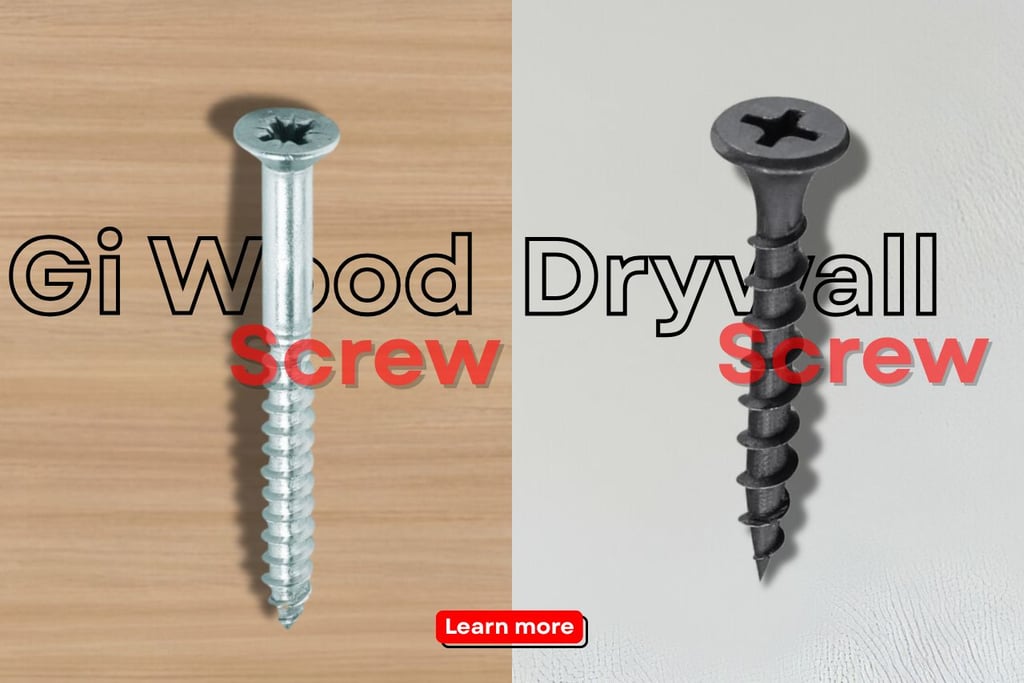Wood Screws vs. Drywall Screws: Key Differences and Uses
Learn the key differences between wood screws and drywall screws. Discover when to use each for construction, furniture assembly, and interior projects.
PRODUCT-SPECIFIC


Introduction
Choosing the right screw for your project is essential to ensure durability, strength, and ease of installation. Wood screws and drywall screws are among the most commonly used fasteners, but they serve distinct purposes. Understanding their differences will help you make the right choice for your construction or furniture project.
What Are Wood Screws?
Wood screws are designed specifically for joining pieces of wood together. They feature a tapered body with a sharp, coarse thread that bites into wood fibers, ensuring a strong grip. These screws often have a partially threaded shaft, allowing for better clamping force between two pieces of wood.
Key Characteristics of Wood Screws
Made from steel, brass, or stainless steel
Available in flat, round, and oval head types
Coarse threading for better wood grip
Often have a slotted or Phillips drive head
Common Uses of Wood Screws
Cabinet and furniture assembly
Framing and structural woodwork
Installing hinges and brackets
DIY woodworking projects
What Are Drywall Screws?
Drywall screws are designed specifically for securing drywall sheets to wooden or metal studs. They have a finer thread than wood screws, allowing them to bite into drywall without causing damage. These screws are made from hardened steel and often feature a black phosphate coating to resist corrosion.
Key Characteristics of Drywall Screws
Made from hardened steel for extra strength
Bugle-shaped head to prevent tearing the drywall paper
Fine or coarse threading depending on the stud material
Typically come with a Phillips drive for easy installation
Common Uses of Drywall Screws
Securing drywall panels to wood or metal framing
Attaching ceiling boards and plasterboard
Light-duty woodwork and non-load-bearing applications
Key Differences Between Wood Screws and Drywall Screws
Thread Design
Wood screws have a coarse thread that grips wood fibers effectively, while drywall screws feature finer threading, especially when used with metal studs.
Material Composition
Wood screws come in a variety of materials, including brass and stainless steel, whereas drywall screws are typically made from hardened steel with a black phosphate coating.
Head Shape
Wood screws come in various head shapes (flat, round, oval), offering versatility in woodworking applications. Drywall screws usually have a bugle head, designed to sit flush with drywall surfaces.
Strength and Durability
Wood screws provide better holding power for heavy wood applications. Drywall screws are brittle in comparison and are designed primarily for securing drywall rather than supporting weight-bearing structures.
When to Use Each Type
Use Wood Screws When:
Working on furniture, cabinetry, or wooden structures
Installing hinges, brackets, or wood panels
Strength and holding power are required
Use Drywall Screws When:
Securing drywall sheets to studs
Attaching lightweight materials to walls or ceilings
Working with non-load-bearing applications
Conclusion
Choosing between wood screws and drywall screws depends on your project's requirements. Wood screws offer strength and durability for woodworking and furniture projects, while drywall screws are ideal for fastening drywall panels securely. Understanding their differences ensures a strong, long-lasting installation for any application.
